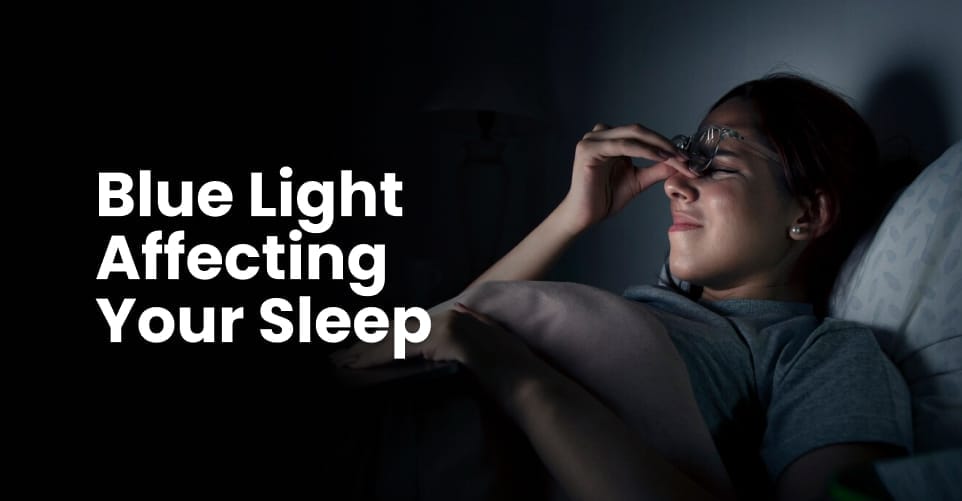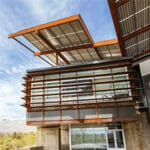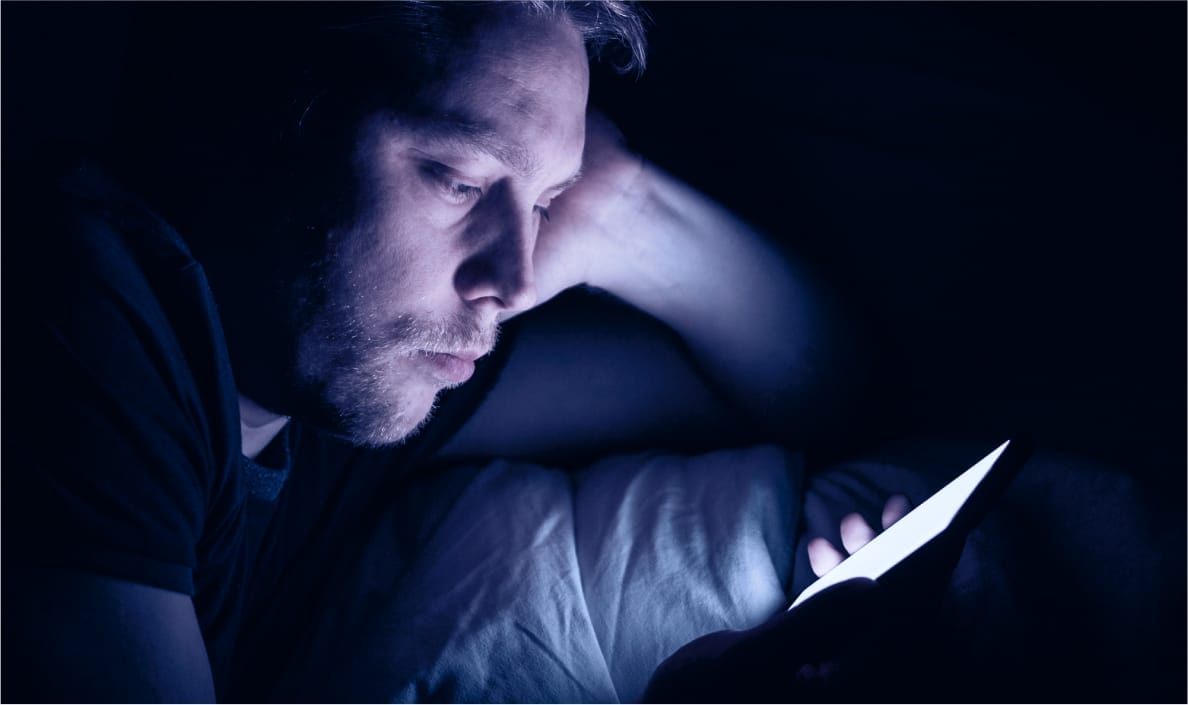Today’s society revolves around one thing: technology. So much so that we cary multiple devices in our pockets daily. When we lie in bed at night, we’re on our phones, whether we’re reading an article, watching a video, or are on social media. But if you find yourself having some trouble falling asleep, you’re phone usage could be the culprit.
Our electronic devices emit blue light, known for its profound impact on sleep quality. Exposure to blue light, especially in the hours before going to bed, can significantly interfere with our natural sleep patterns, leading to sleep disruption.

What is Blue Light?
Blue light is a type of visible light with shorter wavelengths and more energy compared to other colors in the spectrum. It is particularly significant due to its prevalence and impact in the digital age.
Blue light ranges from approximately 380 to 500 nanometers in wavelength, placing it on the higher-energy end of the visible light spectrum. It is known for its vibrant hue, similar to a clear sky.
The most common sources of blue light include:
- Smartphones and Tablets: These devices emit a considerable amount of blue light and are nearly constant companions in our daily lives.
- Computers and Laptops: Essential for work and leisure, these screens are significant sources of more blue light exposure.
- LED Lights: Used in homes and workplaces, LED lighting solutions are energy-efficient and major emitters of artificial blue light.
- Televisions: Modern TVs, especially those using LED technology, contribute to blue light exposure.
Scientific Insights into Blue Light and Sleep
The circadian rhythm, commonly known as the “body clock,” is an internal mechanism that regulates periods of sleepiness and wakefulness over a 24-hour period. Its role is critical in maintaining a stable sleep schedule and overall health. This rhythm is particularly sensitive to environmental light, which helps signal whether it’s time to be awake or asleep.
Blue light has a uniquely powerful effect on the circadian rhythm due to its high energy and short wavelength. It significantly influences the production of melatonin, the hormone that promotes sleep, by suppressing its release in the evening. This suppression can shift our internal clock, making it harder to fall asleep at our usual time and potentially disrupting the natural sleep cycle.
Research Findings on Blue Light and Sleep Quality
A growing body of research has explored how exposure to blue light affects sleep quality and structure. Several studies have shown that using devices emitting blue light in the evening can extend the time it takes to fall asleep, reduce the proportion of REM sleep, and diminish sleep quality. One study by the Proceedings of the National Academy of Sciences of the United States of America (PNAS) revealed that participants using blue light-emitting devices before bed felt less alert the following morning than when using devices emitting less blue light.
Another significant finding from a recent study done by Science Direct entailed 11 healthy young men in three groups being exposed to incandescent light, blue light, and blue light-blocking glasses an hour before going to bed. The participants’ sleep time, ratio of sleep, ratio of deep sleep, and body movements while asleep sleep were all measured using a mat sleep scan. They found that the group exposed to blue light saw a significant decrease in the ratio of deep sleep compared to the two other groups.

Blue Light Affecting Your Sleep Has Health Concerns
The use of digital devices in our daily lives has introduced many health concerns, particularly related to the blue light these devices emit.
Short-Term Effects of Blue Light
Blue light hits sleep quality and patterns hard, and it’s not just about taking longer to fall asleep. After blue light exposure, many people wake up multiple times during the night, and overall sleep quality drops. This can quickly translate into next-day consequences, mood, and cognitive function. People often report feeling more irritable and stressed after a bad night’s sleep. Attention and memory are also affected, which makes it harder to get work done and makes daily tasks more complicated.
Long-Term Health Consequences
The long-term health consequences of continuous blue light exposure and sleep disruption are even scarier. Continuous disruption to the natural sleep cycle has been linked to several chronic diseases. Research shows that poor sleep increases the risk of obesity, diabetes, and heart disease. These conditions are often caused by hormonal imbalances and glucose metabolism, which are both affected by sleep quality.
And the mental health impact over time is huge. Chronic sleep disruption can cause or exacerbate mental health issues like depression and anxiety. Poor sleep impairs the brain’s ability to regulate emotions and process emotional information, which can heighten anxiety and lead to depressive episodes.
Minimize Blue Light Exposure with These Tips
In today’s digital age, it’s important to adopt strategies that help minimize exposure to blue light, particularly during the evening hours when its impact on sleep can be most detrimental. Here are some practical tips for adjusting technology use and lifestyle habits to effectively reduce blue light exposure.
Blocking Out Blue Light
There are ways to block out blue light.
- Tools and Apps to Reduce Blue Light Exposure: Utilize built-in features on many smartphones, tablets, and computers that reduce blue light emission, such as “Night Shift” on Apple devices or “Night Mode” on Android. For screens without this feature, apps like f.lux can adjust your screen to warmer tones after sunset.
- Blue Light-Blocking Glasses: Wear blue light-blocking glasses in the evening while watching TV or using digital devices. These glasses have specially crafted lenses made for blocking blue light from screens, helping reduce eye strain and promote better sleep.
Lifestyle Modifications
Alongside tools, changing your evening habits can further help cut down blue light exposure.
- Recommendations for Evening Routines That Minimize Blue Light Exposure: Create a pre-sleep routine that doesn’t include a blue light-emitting device within two hours of going to bed. Dim the overhead bright light and switch to lamps with warm bulbs. You could also light candles to provide soft illumination that doesn’t interfere with melatonin production.
- Alternative Activities to Screen Time in the Evening: Engage in calming activities that don’t involve electronic screens. Consider reading a physical book, journaling, or practicing mindfulness and meditation. These activities help you unwind and prepare your body and mind for a restful night’s sleep.
Get Better Sleep with Your New Knowledge of Blue Light
It’s tough to run from blue light in today’s digital-age society, but you can minimize it and improve your sleep. By adopting practical measures like wearing blue light glasses, blue light filters and adjusting our device settings, and modifying our nightly routines, we can significantly mitigate this impact.
Let these changes be your stepping stones towards more restful nights and a healthier, more energetic lifestyle.







